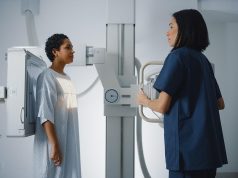Stage shift toward Stage I NSCLC observed following introduction of low-dose CT screening for lung cancer
THURSDAY, March 31, 2022 (HealthDay News) — From 2014 to 2018, there was an increase in the percentage of stage I non-small cell lung cancer (NSCLC) diagnoses in the United States, according to a study published online March 30 in The BMJ.
Alexandra L. Potter, from Massachusetts General Hospital in Boston, and colleagues examined the effect of introduction of low-dose computed tomography screening in 2013 on stage shift in lung cancer diagnosis and survival using data from participants aged 45 to 80 years diagnosed with NSCLC between Jan. 1, 2010, and Dec. 31, 2018.
The researchers found that from 2010 to 2013, there was no significant increase in the percentage of stage I NSCLC patients aged 55 to 80 years (27.8 to 29.4 percent); however, from 2014 to 2018, there was a 3.9 percent increase per year. The increase in the odds per year of a patient having one lung cancer stage lower at diagnosis during 2014 to 2018 was higher than the increase in the odds per year from 2010 to 2013 (multivariable adjusted odds ratio, 1.062). Similarly, there was no increase observed in median all-cause survival of patients aged 55 to 80 years from 2010 to 2013 (from 15.8 to 18.1 months), but an increase of 11.9 percent was seen per year from 2014 to 2018 (from 19.7 to 28.2 months). The hazard of death decreased significantly faster after 2014 versus before 2014. An estimated 10,100 deaths were averted with increases in the detection of early-stage disease from 2014 to 2018.
“The findings of this study indicate the beneficial effect that even a small amount of screening can have on lung cancer stage shifts and survival at the population level,” the authors write.
Copyright © 2022 HealthDay. All rights reserved.








